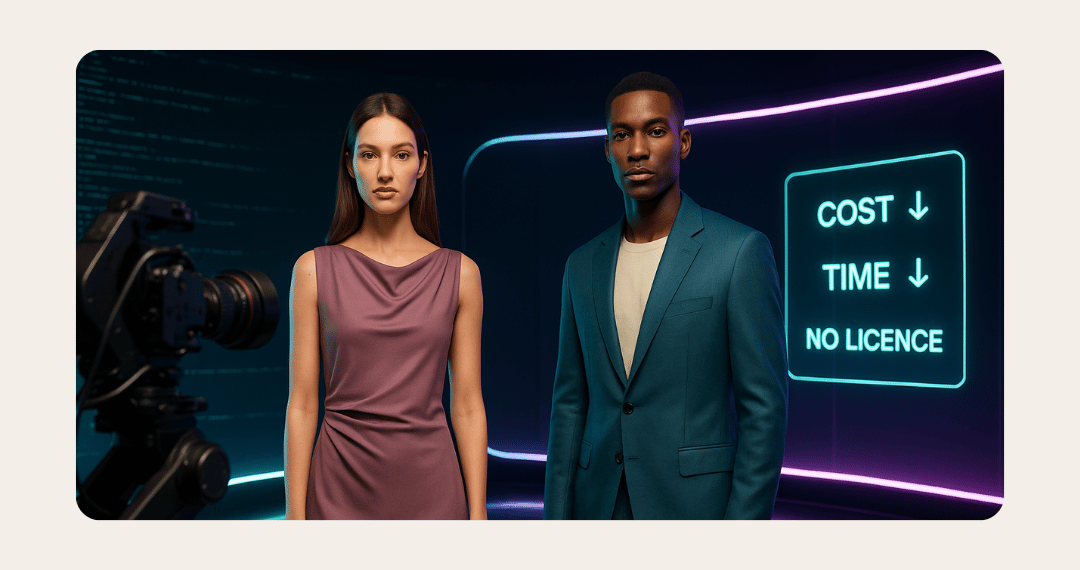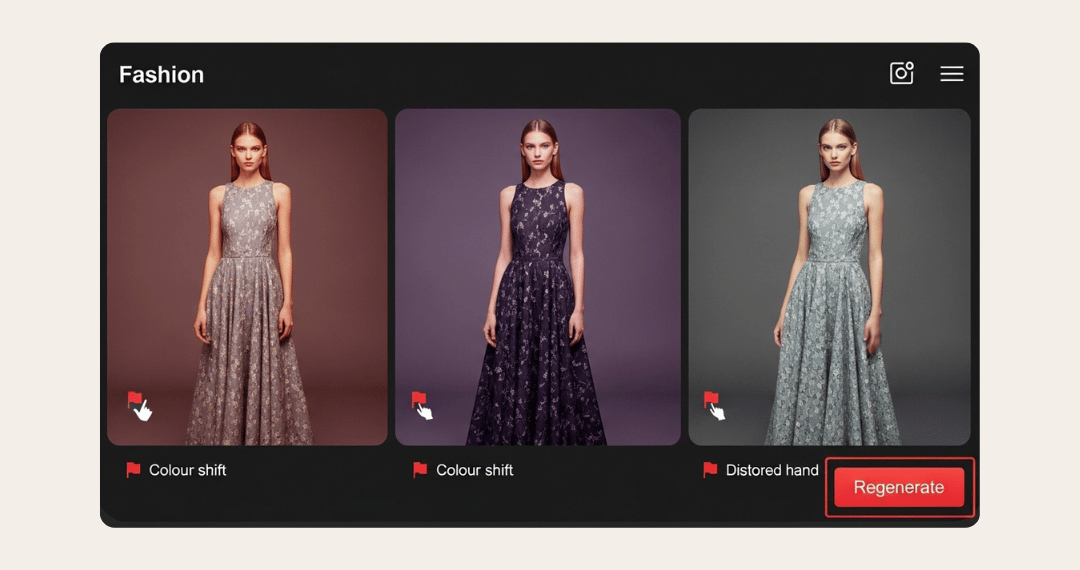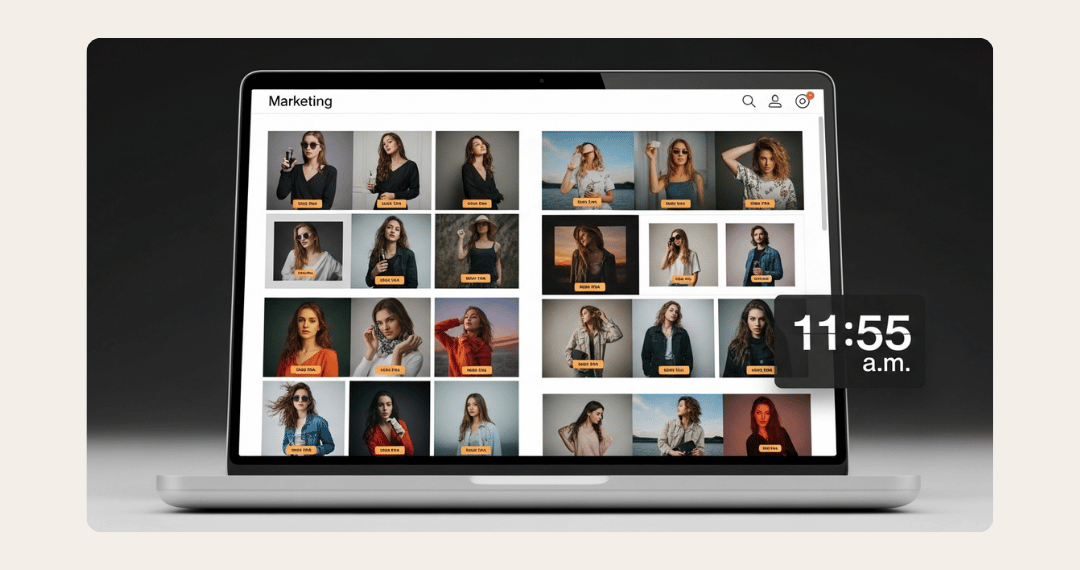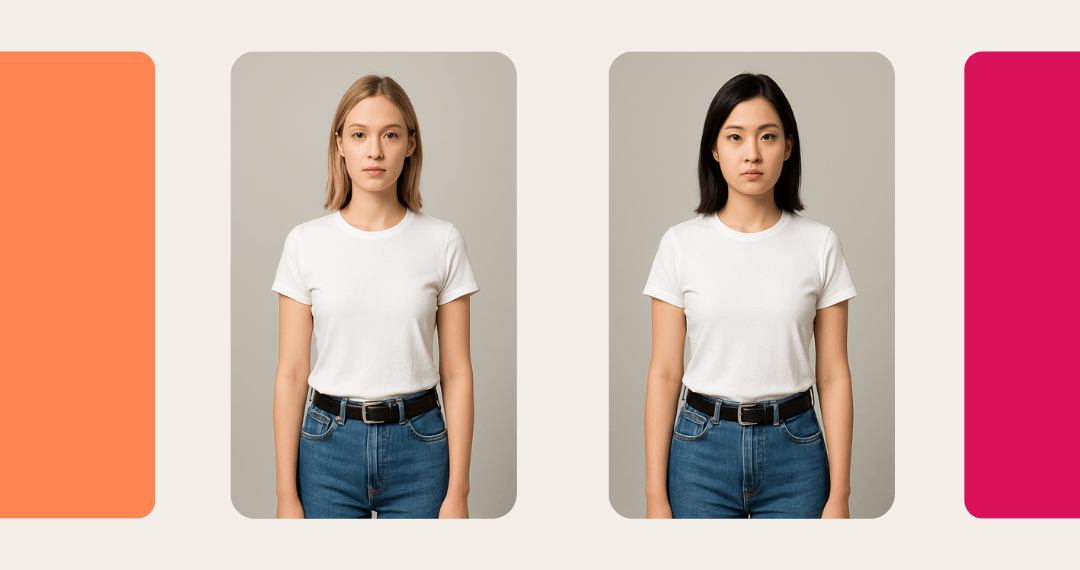No Hidden Fees: Synthetic Models Simplify Image Licensing
The fashion imagery game is changing. Traditional photoshoots with human models come loaded with hidden costs – from repeat licensing fees to legal complexities – that can slow down your content pipeline.
Enter synthetic models: AI-generated human images that look real but carry none of the baggage of rights-managed photography. At Pixit Fashion, we leverage this breakthrough to help brands get high-quality visuals faster, cheaper, and with far fewer legal strings attached. This article compares the old and new paths, shows how synthetic model licensing slashes usage fees and royalties, and outlines the consent and compliance ensuring everyone stays protected.
The Hidden Costs of Rights‑Managed Photography
Traditional fashion photography often operates on a rights-managed licensing model. This means that even after paying for the photoshoot itself (photographer, model, crew, etc.), a brand must pay additional usage fees to actually use the images in specific ways. These fees can pile up quickly. For example, photographers commonly charge on the order of $100–$500 per image for use in a single publication, especially for larger magazines. The exact price depends on how the image is used: a print magazine spread reaching hundreds of thousands might run around $300+ per photo on average , whereas a small local brochure might be at the lower end. Crucially, rights-managed licenses contain limitations – on duration, region, and medium of use. A contract might allow use of the photos for, say, a 3-month social media campaign in North America only. If you later want to run that same image in Europe or extend it for another year, you’re facing another round of negotiations and fees.
Usage fees exist to compensate models and photographers every time their work or likeness generates value for a brand. In modeling contracts it’s standard that a model must agree on where (geography) and how long images of them will be used. The broader the usage (e.g. global ads across print, web, and billboards for 12 months), the higher the fee the brand must pay. There’s often an initial payment for the shoot (sometimes called a Basic Session Fee), and then separate licensing payments for each usage “band” like social media, e-commerce, print advertising, etc., over defined time frames.

This system can become a headache for businesses: every new channel or an extended campaign can trigger royalty renegotiations. If a brand neglects to secure the proper license or exceeds the agreed scope, they also risk legal trouble – a model or photographer could claim infringement or demand additional compensation.
In short, the traditional route is complex and costly. It provides important protections and income for creatives, but for brands it means carefully tracking where each image is used and for how long, lest those “free” marketing images turn into an unexpected invoice later. The friction and delays from these negotiations often slow down the process of getting fresh visuals to your website or lookbook.
How Synthetic Models Eliminate Licensing Fees
Imagine having photorealistic models you can use on your website, social media, and lookbooks without ever paying usage or royalty fees. Synthetic AI-generated models make this possible. Because these images aren’t of an actual person, there’s no model agency or individual demanding ongoing royalties for their likeness. The AI model’s “face” is essentially rights-cleared at creation, giving you broad freedom to use the image as you see fit.
In practice, using synthetic models turns image licensing into mostly a one-and-done deal. You might pay a service fee to generate the images, but once you have the output, you own a license to use it across your channels with no extra royalties. One generative fashion platform explicitly notes that all photos produced on its system are “free from usage rights fees” and can be used freely for commercial purposes. In other words, no surprise bills down the road because you decided to put an image in next season’s catalog or on an extra billboard.
For companies, the financial upside is game-changing. The cost of a traditional photoshoot can run into thousands once you add photographer day rates, model fees, hair/makeup, studio rental, and location permits. Then add recurring licensing fees on top – it’s a major investment per outfit or collection. In contrast, AI-generated fashion imagery can cut those production costs by 90% or more. There’s no physical shoot logistics, and no need to re-pay every time you use the image in a new context. One early adopter reports their AI model service lets them generate product shots for under $1 each, versus a real shoot that would be dozens of times more expensive.

Beyond saving money, synthetic models radically accelerate time-to-market. Need new photos for an impromptu social media campaign or to A/B test a homepage banner? Using for example Pixit’s AI fashion image generator, you can create them on-demand in hours rather than scheduling a shoot weeks out. This agility means retailers can respond to trends faster and refresh their visuals as often as needed without worrying about nickel-and-dime licensing. In fact, many brands find they can go from product design to live images on their webshop 10× faster than before. Consistency is another perk: you can generate the same model in the exact poses or diverse looks you want, anytime, without coordinating a model’s schedule.
Equally important, synthetic images lower legal risk. Since no real person’s likeness is being used, issues like violating a model’s right of publicity largely go away. The images produced are unique and rights-cleared, so you’re not going to get a letter down the line claiming you used someone’s photo outside the agreement – the AI face has no personal claims attached. This simplifies compliance: you still follow the terms of your generation platform (ensuring, for example, you don’t resell the raw images if that’s disallowed ), but you’re freed from the complex consent and attribution requirements that come with human subjects.
Consent and Compliance in the Age of AI Talent
Does the ease of synthetic models mean brands can ignore consent and ethics? Not at all. It simply changes the focus. When no real individual is depicted, you bypass needing a traditional model release. However, companies must ensure their AI-generated models are truly fictional and not unknowingly copying a real person. Ethical AI providers (like Pixit) train models on broad datasets and avoid using any one person’s identity. This ensures the output is a new face, not a clone of a recognizable figure. In effect, the “consent” is baked in by design – the synthetic face doesn’t belong to anyone, so you have full clearance to use it.
Things differ if you venture into hybrid territory, such as creating an AI “digital twin” of a real model. Some brands are experimenting with this: for example, H&M recently announced plans to create AI-generated avatars of 30 human models (with the models’ permission) to use in marketing campaigns. In these cases, the old rules of consent very much apply, just in new formats. Those models would sign agreements allowing their likeness to be reproduced by AI, and crucially, they still expect compensation when their digital double is used. Essentially, the model becomes like a licensor of her avatar – she must consent to how it’s used and for how long, just as she would with a normal photo. H&M has said each model will be paid a fee when their twin is used, negotiated via their agency. So while synthetic tech enables one model to “be in two places at once” image-wise, the brand must handle the rights similarly to a normal shoot unless the model has contractually waived them.

Recognizing the potential for abuse, regulators and industry groups are rolling out new guidelines to protect human talent in the age of AI. In New York, an amendment to the Fashion Workers Act now requires that management companies and brands obtain written consent from models before creating or using a digital replica of them. The consent must clearly detail the scope, purpose, and duration of use of the AI-generated likeness. In fact, as of 2025 it’s law in New York that any contract allowing an AI “synthetic performance” of a model or actor include a specific description of how that digital likeness will be used, unless it’s separately negotiated by union or counsel. This prevents the scenario of a model unwittingly signing away unlimited rights to an AI version of herself. Other regions are following suit – California introduced similar protections for actors which likely set a precedent, and the EU’s upcoming AI Act will even require that AI-generated images be disclosed or watermarked as AI in many cases.
For brands using pure synthetic models (not based on any specific person), complying with the law is straightforward: you should verify your image vendor only produces fictitious faces or has proper licensing for any source material. Essentially, legal compliance shifts toward vetting the AI platform (did it use licensed training data? does it guarantee the outputs don’t infringe anyone’s rights?). When working with Pixit Fashion’s platform, for example, clients can be confident that the models generated are entirely fictional composites, and our terms of service spell out that the images come with broad usage rights to the client, with no hidden royalties. We also include clauses prohibiting malicious use of the technology – for instance, you shouldn’t attempt to reverse-identify or claim a synthetic model is a real person you hired. These measures align with emerging best practices and legislation: consent and control for real individuals, and clear, fair usage terms for AI creations.
Embracing an Efficient, Royalty-Free Future
The switch to synthetic models isn’t just a tech trend – it’s a business evolution. Fashion and retail brands today need to produce more visual content than ever, for an expanding array of digital channels, all while keeping a consistent look and voice. Relying solely on traditional photoshoots is increasingly impractical in this content-hungry environment. By adopting AI-generated models through services like Pixit Fashion, companies can streamline their workflow. No more juggling complex licensing agreements for each image or holding back a campaign launch because you’re waiting on a contract extension from a photographer or model. The images you generate are yours to use when, where, and as long as you need – giving you unprecedented agility.
Of course, human models and photographers will always have a role in high-end creative work and brand storytelling. But for the countless routine product shots and ads that drive e-commerce, synthetic imagery offers a smart alternative. You can maintain quality and diversity (AI models can reflect a wide range of ethnicities, ages, and body types at the click of a button) while cutting costs and time. Early adopters have found that by redirecting budget to AI, they free up resources to invest in other areas (for example, better creative direction or extra marketing campaigns) instead of funneling money into repeated licensing fees. The result is often a higher overall return on investment for marketing spend, since every dollar goes further.
Pixit Fashion is positioned at the forefront of this shift. We’ve designed our platform to deliver the benefits discussed above: photorealistic models on demand, straightforward licensing with no hidden fees, and respect for legal/ethical boundaries. By simplifying image licensing, we empower brands to focus on creative execution and marketing strategy, rather than paperwork and budget gymnastics. Synthetic models turn what used to be a complicated ongoing expense into a one-time production cost. In an industry where freshness and fast turnarounds can make or break sales, this innovation in image creation is enabling fashion businesses to move at the speed of digital culture.
Bottom Line: Embracing AI-generated models means your next photoshoot can take place in a cloud server, not an expensive studio – and once your images are generated, they’re yours to use freely without the fine print. No surprise bills, no frantic calls to lawyers about expiring rights, no compromises on visual quality. Just faster, more flexible content creation. The future of fashion imagery is here, and it’s royalty-free.



